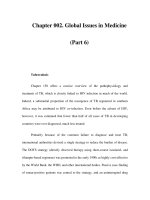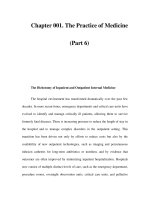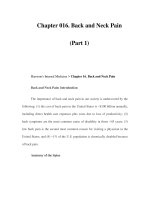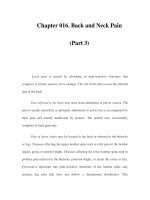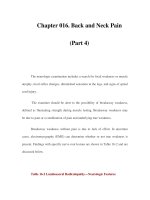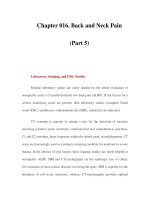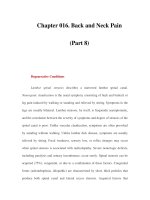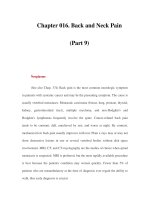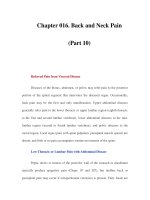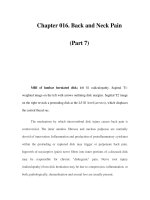Chapter 016. Back and Neck Pain (Part 6) pps
Bạn đang xem bản rút gọn của tài liệu. Xem và tải ngay bản đầy đủ của tài liệu tại đây (57.91 KB, 5 trang )
Chapter 016. Back and Neck Pain
(Part 6)
Congenital Anomalies of the Lumbar Spine
Spondylolysis is a bony defect in the pars interarticularis (a segment near
the junction of the pedicle with the lamina) of the vertebra; the etiology may be a
stress fracture in a congenitally abnormal segment. The defect (usually bilateral) is
best visualized on oblique projections in plain x-rays, CT scan, or single photon
emission CT (SPECT) bone scan and occurs in the setting of a single injury,
repeated minor injuries, or growth. Although frequently asymptomatic, it is the
most common cause of persistent low back pain in adolescents and is often
activity-related.
Spondylolisthesis is the anterior slippage of the vertebral body, pedicles,
and superior articular facets, leaving the posterior elements behind.
Spondylolisthesis can be associated with spondylolysis, congenital anomalies of
the lumbosacral junction, infection, osteoporosis, tumor, trauma, prior surgery, or
degenerative spine disease. It occurs more frequently in women. The slippage may
be asymptomatic or may cause low back pain and hamstring tightness, nerve root
injury (the L5 root most frequently), or symptomatic spinal stenosis. Tenderness
may be elicited near the segment that has "slipped" forward (most often L4 on L5
or occasionally L5 on S1). A "step" may be present on deep palpation of the
posterior elements of the segment above the spondylolisthetic joint. The trunk may
be shortened and the abdomen protuberant as a result of extreme forward
displacement of L4 on L5; in severe cases cauda equina syndrome (CES) may
occur (see below). Surgery is considered for symptoms persisting for >1 year that
do not respond to conservative measures (e.g., rest, physical therapy). Surgery is
usually indicated for cases with progressive neurologic deficit, abnormal gait or
postural deformity, slippage > 50%, or scoliosis.
Spina bifida occulta is a failure of closure of one or several vertebral arches
posteriorly; the meninges and spinal cord are normal. A dimple or small lipoma
may overlie the defect. Most cases are asymptomatic and discovered incidentally
during evaluation for back pain.
Tethered cord syndrome usually presents as a progressive cauda equina
disorder (see below), although myelopathy may also be the initial manifestation.
The patient is often a young adult who complains of perineal or perianal pain,
sometimes following minor trauma. Neuroimaging studies reveal a low-lying
conus (below L1-L2) and a short and thickened filum terminale.
Trauma
A patient complaining of back pain and inability to move the legs may have
a spinal fracture or dislocation, and, with fractures above L1, spinal cord
compression. Care must be taken to avoid further damage to the spinal cord or
nerve roots by immobilizing the back pending results of x-rays.
Sprains and Strains
The terms low back sprain, strain, or mechanically induced muscle spasm
refer to minor, self-limited injuries associated with lifting a heavy object, a fall, or
a sudden deceleration such as in an automobile accident. These terms are used
loosely and do not clearly describe a specific anatomic lesion. The pain is usually
confined to the lower back, and there is no radiation to the buttocks or legs.
Patients with paraspinal muscle spasm often assume unusual postures.
Traumatic Vertebral Fractures
Most traumatic fractures of the lumbar vertebral bodies result from injuries
producing anterior wedging or compression. With severe trauma, the patient may
sustain a fracture-dislocation or a "burst" fracture involving the vertebral body and
posterior elements. Traumatic vertebral fractures are caused by falls from a height
(a pars interarticularis fracture of the L5 vertebra is common), sudden deceleration
in an automobile accident, or direct injury. Neurologic impairment is common,
and early surgical treatment is indicated. In victims of blunt trauma, CT scans of
the chest, abdomen, or pelvis can be reformatted to detect associated vertebral
fractures.
Lumbar Disk Disease
This is a common cause of chronic or recurrent low back and leg pain
(Figs. 16-3 and 16-4). Disk disease is most likely to occur at the L4-L5 and L5-S1
levels, but upper lumbar levels are involved occasionally. The cause is often
unknown; the risk is increased in overweight individuals. Disk herniation is
unusual prior to age 20 and is rare in the fibrotic disks of the elderly. Degeneration
of the nucleus pulposus and the annulus fibrosus increases with age and may be
asymptomatic or painful. Genetic factors may play a role in predisposing some
patients to disk degeneration. The pain may be located in the low back only or
referred to the leg, buttock, or hip. A sneeze, cough, or trivial movement may
cause the nucleus pulposus to prolapse, pushing the frayed and weakened annulus
posteriorly. With severe disk disease, the nucleus may protrude through the
annulus (herniation) or become extruded to lie as a free fragment in the spinal
canal.
Figure 16-4
